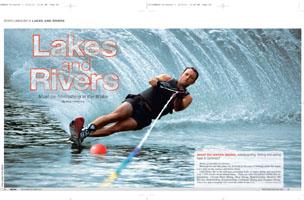
What do water skiing, wakeboarding, fishing and sailing have in common?
Water, preferably not frozen.
Watersports can take place on, in or (as in the case of fishing) under the water. Let's start on the surface and move down.
USA Water Ski is the national governing body of water skiing and sanctions over 1,000 events on an annual basis. There are nine disciplines within this organization: 3-Event Water Skiing, Show Skiing, Wakeboarding, Barefoot, Ski Racing, Hydrofoiling, Kneeboarding, Collegiate Skiing and Disabled Skiing. There are approximately 630 local ski clubs in the U.S.
Water skiing, wakeboarding and kneeboarding are considered relatively new, with water skiing making its Olympic debut in 1972. Fishing, sailing, rowing and rafting are arguably the oldest water sports, with fishing dating back 40,000 years.
In 1967, the Bass Anglers Sportsman Society (B.A.S.S.) was established with 106 anglers and has grown to more than 500,000 members across the U.S. They oversee 26 fishing events leading to their largest, the BassMaster Classic. These are nine Elite Series, nine Open Series; and seven Federation Nation. (Outside of B.A.S.S there are thousands of other events held around the country).
Bodies and Conditions
With all the disciplines under the USA Water Ski umbrella, diverse waters are utilized.
 |
| Photo courtesy of USA Waterski |
According to Bob Crowley, executive director of USA Water Ski, “It varies greatly between the different disciplines. The majority of our events are held on private lakes built specifically for waterskiing. The 3-Event water skiing is really picky about water conditions. That’s why the majority takes place on private lakes. It’s a controlled environment, and the wind factor is minimized as are other boats.”
“Show skiing runs their events on rivers and big public waterways,” noted Crowley. “They are not so much concerned about condition of the water. Rather, they want to make sure they are available to the spectator.”
The World Wakeboarding Association is a non-profit organization that sanctions 15-20 events, 12 of them internationally. “All of our events are primarily on rivers and lakes,” said Rob Corrum of the WWA. “Nine of those contests are held on smaller bodies of water or a cable park.”
Cable parks allow wakeboarders to compete on a body of water with an overhead cable system pulling the rider. This system opens up a more affordable market to competitors who do not own boats. There are approximately 160 parks worldwide.
“The smoother the water, the better,” said Corrum. “We want the water to be at least 10 feet deep, 150 feet wide and about 1500 feet long. We always look for a good location that spectators can come and have a good place to watch from and that it is good for the riders as well.”
Lake Murray in South Carolina is ideal for a number of watersports but has created a niche with fishing. The lake is 14 miles wide, 41 miles long with ample coves for both water skiing and anglers.
 |
| Photo courtesy of USA Waterski |
No water? No problem
Without a natural water source, the show can go on. Oklahoma City re-introduced water to the Oklahoma River with a revitalization effort, creating a new waterway through downtown.
“We didn’t have water in our river until 2004,” noted Sue Hollenbeck of the Oklahoma City Convention & Visitors Bureau. “Since it’s manmade, there is a straight line. It’s ideal as a venue for rowing, canoe and kayak and is wide enough for Olympic training. Our biggest obstacle is to convince people there is water here and it’s great.”
Fishing for success
In fishing, professional anglers have a common goal. “The biggest event is the Bassmaster Classic,” said Michael Mulone, Director, Event Partnerships with B.A.S.S. “It’s the Super Bowl of fishing. A lot of suppliers come out and it’s the place to be and the place to be seen.”
Anglers compete for a $500,000 first place prize annually. This year’s event was held at the Louisiana Delta in New Orleans in February and attracted 137,000 people during the three-day tournament.
Smith Mountain Lake in Rocky Mount, Virginia hosted an Elite series with the 2011 Oakley Big Bass Tour, attracting 270 anglers and their families in May.
“We host a number of national fishing tournaments,” said Debra Weir, Tourism and Special Events Manager for the Franklin County Commerce & Leisure Services. “Fishing is very important and Smith Mountain Lake is good for all types of fish.”
 |
| Photo courtesy of lake Murray Country |
Smith Mountain Lake is a 22,000-acre freshwater lake. Down the road is 42-acre Sail Top Lake. Both offer great options for skiers and anglers.
Mulone had great praise for their event. “Franklin and Bedford Counties were great hosts for our Bassmaster Elite Series tournament on Smith Mountain Lake. Not only did they rally the community with local marketing, but they had great on-site elements, from a kid's fishing derby to Big Air Dogs, and a local company creating a B.A.S.S.-inspired ice cream with chocolate fish. Over the four-day event, we surpassed 15,000 attendees."
In May 2011, Lake Murray hosted the Evan William Bourbon Carolina Class Bassmaster Elite Series with over 200 anglers and an average of 3,000 people per day attending the weigh-ins. The American Fishing Tour National Championships are slated for October 21-29, 2011 and will attract 700-800 anglers and their families, resulting in an estimated 7,000 room nights for the area.
In 2008, Lake Murray hosted the Forrest Wood Cup, the final tournament event on the FLW Outdoor Series. FLW Outdoor(the sanctioning organization for a series of sport fishing tours) will host 191 bass tournaments in 2011.
Multiple events on water
Oklahoma City’s Oklahoma River was a site for several events. In August 2010, it attracted more than 1,600 athletes to the US Rowing Master National Championships. In September, the USA Rowing World Challenge prepared teams there for the 2012 Olympic Games in London. Additionally, the USA Wakeboard used the river for the 13th USA Wakeboard Nationals, the 5th National Wakesurf Championships and the USA Wakeboard Cable Nationals.
 |
| photo courtesy of USA Waterski |
“We’ve done a great job in securing relationships and working with USA Waterski and Wakeboard,” said Hollenbeck. “The venue is a great athletic venue and great for spectators.”
Waters Edge Estates in Wilmington, Illinois hosted the 69th Annual GOODE Water Ski National Championships in August 2010 for the second consecutive year. Approximately 800 competitors and their families attended the event.
The 2011, Global Invitational Water Ski Championships were held at Millenium Park in Grand Rapids, Michigan. Top athletes competed in Lake Michigan in slalom, long distance jumping, free-style jumping, wakeboarding, barefoot, hydrofoil and show skiing, all in front of an estimated 10,000 spectators. Macatawa Bay Yacht Club hosted the 2011 Canada’s Cup there in September.
Regional, county and state events keep lakes and rivers busy, as well as interesting. Rocky Mount hosts a three-day river festival paddling event. Approximately 200-300 participants paddle down Black Water River in the evening. Paddlers have to have a light on their boat, and many get creative, using materials like glow sticks. The remainder of the event is the Pigg River Ramble where participants compete in canoes and kayaks for seven miles.
 |
| Photo courtesy of USA Waterski |
Landing the big one
Having a body of water is most likely the biggest decision maker for the event planners, but there are other factors to consider when choosing a destination.
“We really look for community support,” said Mulone. “For the most part if the city has the infrastructure to host a tournament they are easy gatekeepers. We are looking for a partner. They can wrap their arms around B.A.S.S. and we can wrap around them.”
Crowley looks for that community support as well. “What we are looking for is an organizing committee, and that’s where the clubs come into play. They are key,” said Crowley.
Other vital components are accommodations, accessibility and area restaurants.
“We do require a major international airport to be within a 45-minute drive,” said Corrum. “We typically hold our events in major cities.”
A variety of hotels suit the athletes. “I think the key is the price point on the rooms,” said Crowley. “They don’t need to be four- or five-star hotels. Price point is around $89. We have 50 officials come in for an event and usually put them at the host hotel. There is always a 15- to 20-minute drive for us. We are used to being flexible.”
Oklahoma City defies what most planners expect. “One of the best things about our river is that it’s located in our downtown,” said Hollenbeck. “You are close to the entertainment district and you don’t have to drive 30 minutes to get to the venue. There are seven hotels in the downtown area.”
Anglers competing in B.A.S.S. tournaments take a more non-traditional route than their counterparts. “We reach all aspects of it,” said Mulone. “Approximately 15-20 percent camp, 55 percent stay in hotels and the others are in private home rentals. We are great for limited service hotels and mom-and-pop businesses.”
B.A.S.S. is a great fit for Smith Mountain Lake. Franklin County has a number of locally-owned hotels and many restaurants. The state park provides camping, water access, cabins and more. There are also rental homes on the lake and two resorts.
Planners also work hand in glove on securing the necessary permits, licenses and insurance for hosting events on the water.
“Permits vary from discipline to discipline,” explained Crowley. “Local organizers usually have an agreement with the city or park and they obtain those permits. We handle the insurance as a governing body in most cases, and if there is an additional need, we can obtain it for them.”
Similarly, World Wakeboard Association and B.A.S.S. work closely with the destination. “We ensure our company has the correct permits and licenses but there are some states that require a fishing tournament permit. We work with the local agencies,” said Mulone.
Media Affect
Fishing has grown exponentially over the years not only through growth from the number of tournaments, but more notably, the media.
ESPN, TNN and the Outdoor Channel all feature shows dedicated to fishing, and B.A.S.S. has numerous shows of its own. Recreational fishing has an overall annual economic impact of $125 billion in the United States. The website, Bassmaster.com, receives up to one million hits per day during tournament time.
Lake Murray saw this impact firsthand in 2008 with the Forrest Wood Cup. “The event was broadcast to 81 million homes in the U.S. over two months on the World Fishing Network and more than 249 million households internationally as well as being broadcast on the Armed Forces Network to the U.S. military stationed in Iraq and Afghanistan,” said Atria.
“The economic impact was over $16 million,” she noted. “If you add to that, the advertising revenue was an additional $7.5 million as well as media impressions of 113 billion. The total economic impact for our area was $36.5 million.”
B.A.S.S. chooses destinations that are willing to partner with them and receive the media exposure. “It’s a lot more than just a regular old fishing tournament,” said Mulone. “It’s also the media component and the national exposure with all the media outlets covering us.”
Just around the river bend...
Some say that wakeboarding is propelling watersports to the forefront the same way that snowboarding did for snow sports. The United States Olympic Committee announced in July that wakeboard will be considered among seven other sports for a spot in the 2020 Olympics.
According to USA Waterski, 50 percent of their 20,000 members have incomes over $90,000 and the website, usawaterski.org, receives 20,000 hits per day. Clearly, the water is the place to be for sports destinations.
So whether you prefer the challenge of catching a fish or catching a wave, jump in. The water’s fine.

